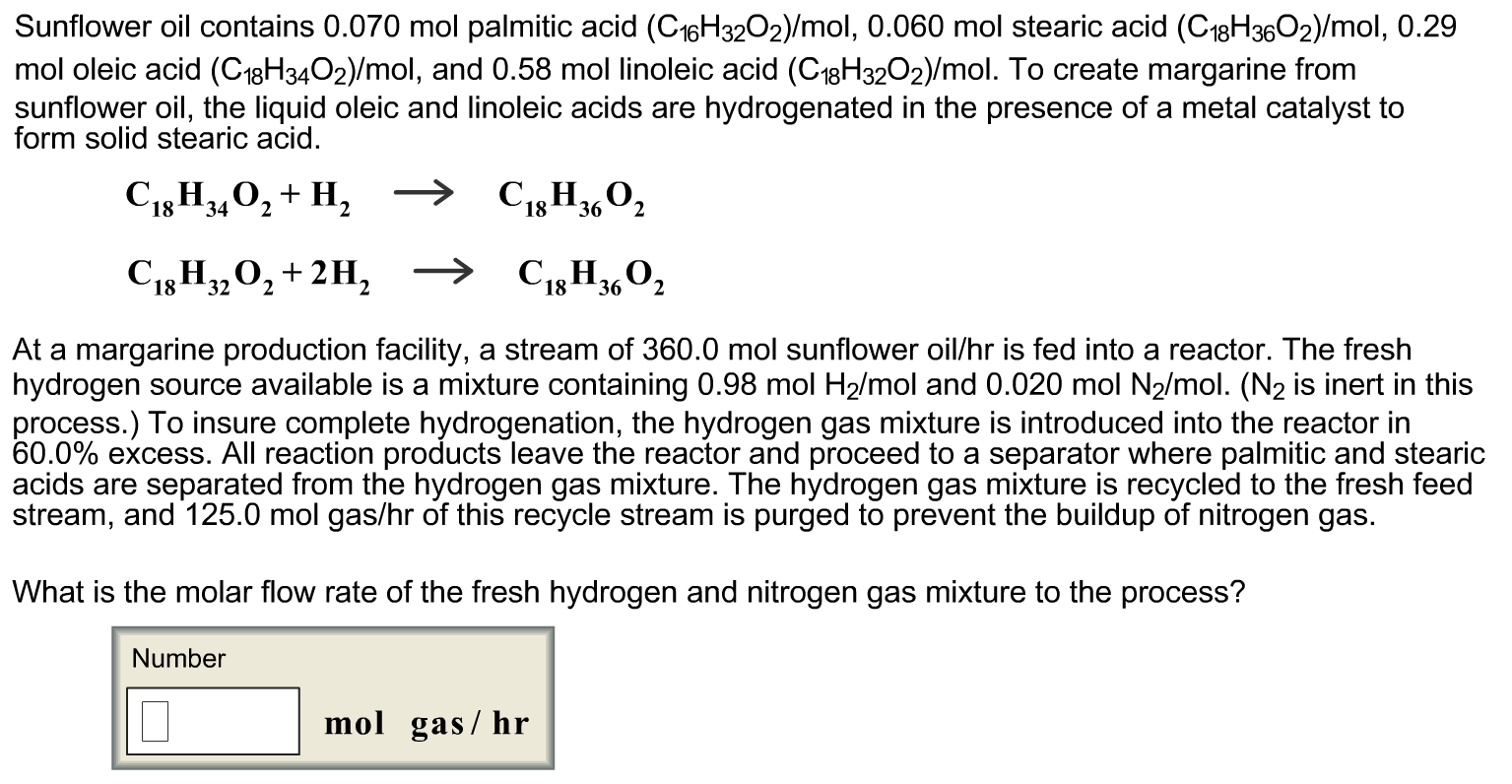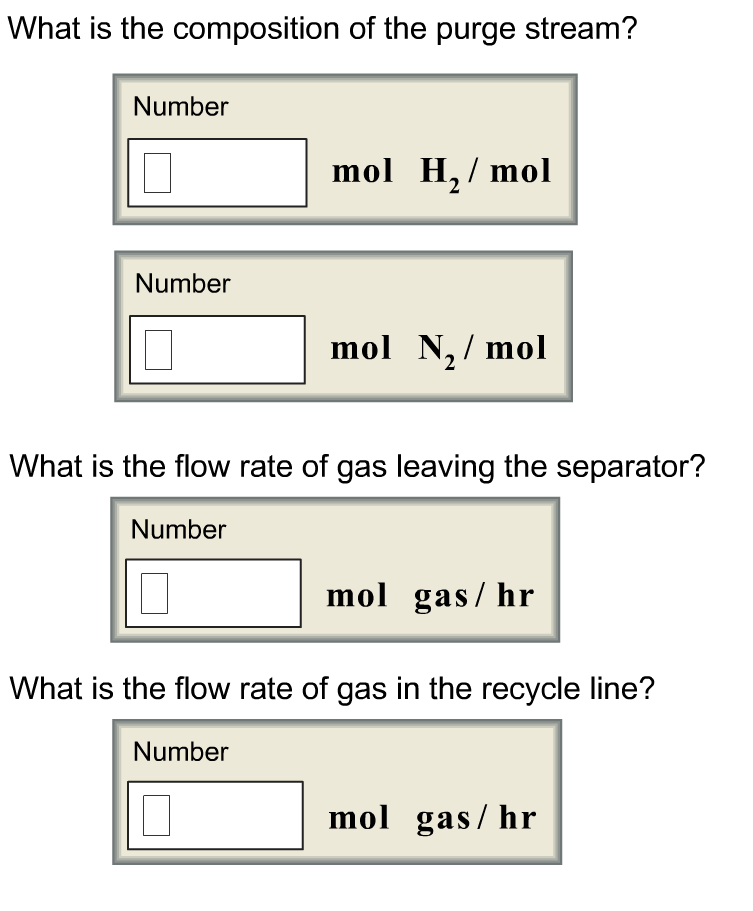
Introduction to Chemical Engineering Thermodynamics
8th Edition
ISBN: 9781259696527
Author: J.M. Smith Termodinamica en ingenieria quimica, Hendrick C Van Ness, Michael Abbott, Mark Swihart
Publisher: McGraw-Hill Education
expand_more
expand_more
format_list_bulleted
Question
Help with all questions.

Transcribed Image Text:Sunflower oil contains 0.070 mol palmitic acid (C16H32O2)/mol, 0.060 mol stearic acid (C18H3602)/mol, 0.29
mol oleic acid (C18H3402)/mol, and 0.58 mol linoleic acid (C18H32O2)/mol. To create margarine from
sunflower oil, the liquid oleic and linoleic acids are hydrogenated in the presence of a metal catalyst to
form solid stearic acid.
C13H,0, + H, →
C18H3,02
2
C13 H,0, +2H, → C,H3,O,
At a margarine production facility, a stream of 360.0 mol sunflower oil/hr is fed into a reactor. The fresh
hydrogen source available is a mixture containing 0.98 mol H2/mol and 0.020 mol N2/mol. (N2 is inert in this
process.) To insure complete hydrogenation, the hydrogen gas mixture is introduced into the reactor in
60.0% excess. All reaction products leave the reactor and proceed to a separator where palmitic and stearic
acids are separated from the hydrogen gas mixture. The hydrogen gas mixture is recycled to the fresh feed
stream, and 125.0 mol gas/hr of this recycle stream is purged to prevent the buildup of nitrogen gas.
What is the molar flow rate of the fresh hydrogen and nitrogen gas mixture to the process?
Number
mol gas/ hr

Transcribed Image Text:What is the composition of the purge stream?
Number
mol H, / mol
Number
mol N,/ mol
What is the flow rate of gas leaving the separator?
Number
mol gas/ hr
What is the flow rate of gas in the recycle line?
Number
mol gas/ hr
Expert Solution
This question has been solved!
Explore an expertly crafted, step-by-step solution for a thorough understanding of key concepts.
This is a popular solution
Trending nowThis is a popular solution!
Step by stepSolved in 7 steps with 7 images

Knowledge Booster
Learn more about
Need a deep-dive on the concept behind this application? Look no further. Learn more about this topic, chemical-engineering and related others by exploring similar questions and additional content below.Similar questions
- Hand Boiler Popular Culture Supporting Material/Supporting Point Supporting Material/Supporting Point Supporting Material/Supporting Point Please include your sources if used.arrow_forward4. Explain what happens during hot working. How is this different than cold working?arrow_forwardDescribe the electron configuration of a sodium atom and explain how it determines its chemical properties.arrow_forward
arrow_back_ios
SEE MORE QUESTIONS
arrow_forward_ios
Recommended textbooks for you
 Introduction to Chemical Engineering Thermodynami...Chemical EngineeringISBN:9781259696527Author:J.M. Smith Termodinamica en ingenieria quimica, Hendrick C Van Ness, Michael Abbott, Mark SwihartPublisher:McGraw-Hill Education
Introduction to Chemical Engineering Thermodynami...Chemical EngineeringISBN:9781259696527Author:J.M. Smith Termodinamica en ingenieria quimica, Hendrick C Van Ness, Michael Abbott, Mark SwihartPublisher:McGraw-Hill Education Elementary Principles of Chemical Processes, Bind...Chemical EngineeringISBN:9781118431221Author:Richard M. Felder, Ronald W. Rousseau, Lisa G. BullardPublisher:WILEY
Elementary Principles of Chemical Processes, Bind...Chemical EngineeringISBN:9781118431221Author:Richard M. Felder, Ronald W. Rousseau, Lisa G. BullardPublisher:WILEY Elements of Chemical Reaction Engineering (5th Ed...Chemical EngineeringISBN:9780133887518Author:H. Scott FoglerPublisher:Prentice Hall
Elements of Chemical Reaction Engineering (5th Ed...Chemical EngineeringISBN:9780133887518Author:H. Scott FoglerPublisher:Prentice Hall
 Industrial Plastics: Theory and ApplicationsChemical EngineeringISBN:9781285061238Author:Lokensgard, ErikPublisher:Delmar Cengage Learning
Industrial Plastics: Theory and ApplicationsChemical EngineeringISBN:9781285061238Author:Lokensgard, ErikPublisher:Delmar Cengage Learning Unit Operations of Chemical EngineeringChemical EngineeringISBN:9780072848236Author:Warren McCabe, Julian C. Smith, Peter HarriottPublisher:McGraw-Hill Companies, The
Unit Operations of Chemical EngineeringChemical EngineeringISBN:9780072848236Author:Warren McCabe, Julian C. Smith, Peter HarriottPublisher:McGraw-Hill Companies, The

Introduction to Chemical Engineering Thermodynami...
Chemical Engineering
ISBN:9781259696527
Author:J.M. Smith Termodinamica en ingenieria quimica, Hendrick C Van Ness, Michael Abbott, Mark Swihart
Publisher:McGraw-Hill Education

Elementary Principles of Chemical Processes, Bind...
Chemical Engineering
ISBN:9781118431221
Author:Richard M. Felder, Ronald W. Rousseau, Lisa G. Bullard
Publisher:WILEY

Elements of Chemical Reaction Engineering (5th Ed...
Chemical Engineering
ISBN:9780133887518
Author:H. Scott Fogler
Publisher:Prentice Hall


Industrial Plastics: Theory and Applications
Chemical Engineering
ISBN:9781285061238
Author:Lokensgard, Erik
Publisher:Delmar Cengage Learning

Unit Operations of Chemical Engineering
Chemical Engineering
ISBN:9780072848236
Author:Warren McCabe, Julian C. Smith, Peter Harriott
Publisher:McGraw-Hill Companies, The